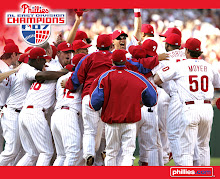(The following is an excerpt from Baseball Prospectus 2011, and may contain spoilers.)
Prior to the 21st Century, the Philadelphia Phillies were rarely considered a model franchise. Rarely lucky or good, the embattled ballclub limped through the years, their record oft-charred by crippling injuries and questionable personnel decisions. With the exception of a few staggered oases (1915, 1950, 1980, 1983, and 1993), the name "Phillies" was synonymous with mediocrity, or worse. Often, much, much worse. The Phillies became the first MLB team to lose 10,000 games, a testament to their longevity as a franchise, as well as to their sustained impotence between the lines.
Things have gone a bit better for the Phils, in the current millennium. Actually, that is an understatement of similar magnitude to statements such as "Roy Halladay is a workhorse.", or "Placido Polanco has a sizeable melon." In making their third consecutive World Series appearance, and winning their second World Championship of the Century, the 2010 Phillies were certainly the greatest edition in the team's history. The 102 regular-season wins posted by the club still left the franchise 1087 games below .500 for their history, but this now-model franchise appears to mere decades away from a lifetime winning record. The only burning question is how they are going to able to afford to continue to roster so many superstars.
The success of the 2010 Phillies has to be, mostly, attributed to their outstanding starting pitching. Acquiring Roy Halladay was expensive, both in terms of salary, and players. The 2010 Cy Young award winner was worth every penny, and every promising prospect. Besides posting one of the best statistical seasons in baseball history, the tireless ace set the standard for MLB's best rotation. The sturdy staff had four hurlers exceed 200 IP, completing an impressive thirty-two games. Trusting in the NL's best defense, the starters were able to go deep into games, while still keeping their pitch counts manageable. Cole Hamels was the same ace he has been his entire career, without the BABIP issues that had plagued his 2009 season. Joe Blanton continued his evolution from proclaimed innings-eater, to actual, quality innings-eater. J.A. Happ continued to bend BABIP to his will, prompting sabermetricians to question whether the southpaw was simply a two-season outlier, or whether a deeper magic was in play. Kyle Kendrick took over the fifth spot in May, replacing veteran Jamie Moyer. Kendrick held the fort at the back of the rotation, until the Phils' second annual acquisition of Cliff Lee further solidified the starting pitching. Hamels and Lee combined to split the six postseason victories not claimed by Halladay.
The health and performance of the starting pitchers also had a beneficial effect on the bullpen. Closer Brad Lidge flourished with a reduced workload, rarely being required to pitch in consecutive games. The Phils' offseason signings of well-traveled vets Jose Contreras and Danys Baez had appeared somewhat questionable at the time, but they demonstrated the club's wisdom in roster construction, performing well in their middle relief roles. Holdovers Ryan Madson and Chad Durbin had career years, excelling as Lidge's setup men. Only reliever J.C. Romero struggled, as injury and legal woes continued to derail his career.
While the pitching gets most of the credit for the Phillies' success, perhaps deservingly so, the club's position players also were quite deserving of merit. Chase Utley's MVP season, Ryan Howard's 52 HRs, and Bearded Jayson Werth's contract year performance keyed the offense. Shane Victorino was second to only Werth among NL outfielders, in launching 31 HRs. While Victorino's sudden power surge was as shocking as his uncanny ability to design and sell $40 t-shirts, he certainly wasn't the Phillies biggest surprise in 2010.
Brian Bocock entered Spring Training hoping to claim a roster spot with the Lehigh Valley IronPigs (AAA). By the time the regular season began, Bocock had, in fact claimed a roster spot. As the parent club's starting shortstop. Jimmy Rollins, the 2007 NL MVP, was relegated to the utility role that had seemed destined for light-hitting Juan Castro. Bocock's numbers at the plate were less reminiscent of Rollins, and more reminiscent of former Phils neophyte Joe Millette. However, Bocock also posted one of the greatest defensive seasons in the game's history, a UZR-heavy 9.2 WAR, and a third place finish in the NL Gold Glove voting. Rollins, dealt to Boston on May 11, did win a Gold Glove. But the Phillies' enlightened decision to install Bocock as the starter early in the season allowed them to maximize their return for Rollins, as well as to free up the payroll that, later, allowed them to fit Lee into their $140MM budget.
(BP2011 will be available in January 2011, wherever fine books are sold.)
Subscribe to:
Post Comments (Atom)


No comments:
Post a Comment